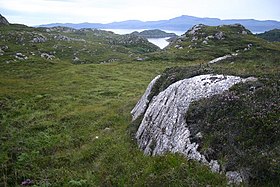Basement (geology)

In geology, basement and crystalline basement are crystalline rocks lying above the mantle and beneath all other rocks and sediments. They are sometimes exposed at the surface, but often they are buried under miles of rock and sediment.[1] The basement rocks lie below a sedimentary platform or cover, or more generally any rock below sedimentary rocks or sedimentary basins that are metamorphic or igneous in origin. In the same way, the sediments or sedimentary rocks on top of the basement can be called a "cover" or "sedimentary cover".
Basement rock consists of continental crustal rock which has been modified several times through tectonic events including deformation, metamorphism, deposition, partial melting and magmatism.[1]
Continental crust
Basement rock is the thick foundation of ancient, and oldest,
Basement rock is visible, for example, at the bottom of the
Age
The basement rocks of the continental crust tend to be much older than the oceanic crust.[3] The oceanic crust can be from 0–340 million years in age, with an average age of 64 million years.[4] Continental crust is older because continental crust is light and thick enough so it is not subducted, while oceanic crust is periodically subducted and replaced at subduction and oceanic rifting areas.
Complexity
This section needs additional citations for verification. (January 2019) |
The basement rocks are often highly metamorphosed and complex, and are usually
Much of the basement rock may have originally been oceanic crust, but it was highly metamorphosed and converted into continental crust. It is possible for oceanic crust to be subducted down into the Earth's mantle, at subduction fronts, where oceanic crust is being pushed down into the mantle by an overriding plate of oceanic or continental crust.
Volcanism
When a plate of oceanic crust is subducted beneath an overriding plate of oceanic crust, as the underthrusting crust melts, it causes an upwelling of magma that can cause volcanism along the subduction front on the overriding plate. This produces an oceanic volcanic arc, like Japan. This volcanism causes metamorphism, introduces igneous intrusions, and thickens the crust by depositing additional layers of extrusive igneous rock from volcanoes. This tends to make the crust thicker and less dense, making it immune to subduction.[6]
Oceanic crust can be subducted, while continental crust cannot. Eventually, the subduction of the underthrusting oceanic crust can bring the volcanic arc close to a continent, with which it may collide. When this happens, instead of being subducted, it is
As such, the basement rock can become younger going closer to the edge of the continent. There are exceptions, however, such as
Cratons
Continents can consist of several continental
Usage
In European geology, the basement generally refers to rocks older than the Variscan orogeny. On top of this older basement Permian evaporites and Mesozoic limestones were deposited. The evaporites formed a weak zone on which the harder (stronger) limestone cover was able to move over the hard basement, making the distinction between basement and cover even more pronounced.[citation needed]
In
When discussing the Trans-Mexican Volcanic Belt of Mexico the basement include Proterozoic, Paleozoic and Mesozoic age rocks for the Oaxaquia, the Mixteco and the Guerrero terranes respectively.[8]
The term basement is used mostly in disciplines of geology like basin geology, sedimentology and petroleum geology in which the (typically Precambrian) crystalline basement is not of interest as it rarely contains petroleum or natural gas.[9] The term economic basement is also used to describe the deeper parts of a cover sequence that are of no economic interest.[10]
See also
- Shield – Large stable area of exposed Precambrian crystalline rock
- Bedrock – Solid rock under loose surface material
References
- ^ a b
 This article incorporates public domain material from Map Shows Content and Origins of the Nation’s Geologic Basement. United States Geological Survey. April 23, 2015.
This article incorporates public domain material from Map Shows Content and Origins of the Nation’s Geologic Basement. United States Geological Survey. April 23, 2015.
- ^ "Bedrock | Encyclopedia.com". www.encyclopedia.com. Retrieved 2019-04-09.
- ^ "Basement domain list by region". USGS.
- S2CID 224967179.
- ISBN 0-442-28125-0.
- ^ "Volcanism". Encyclopedia Britannica. Retrieved 2019-04-09.
- ISBN 978-1-86239-220-5.
- ISBN 978-0-8137-2422-5. Special Paper 422.
- ^ Gay, Parker (2002) Mapping Geologic Structure of Basement and Role of Basement in Hydrocarbon Entrapment, Search and Discovery Article #40052 (adapted from: AAPG Explorer (November and December, 1999)
- ^ Mulhadiano, JAS (1984). The Determination of Economic Basement of Rock Formation in Exploring the Langkat–Medan Area, North Sumatra Basin. 13th Annual Convention Proceedings Indonesian Petroleum Association. Vol. 1. AAPG. pp. 75–107. Retrieved 2019-04-09.
Sources
- Parker, Sybil P., ed. (2003). McGraw-Hill dictionary of geology and mineralogy (2nd ed.). New York: McGraw-Hill. OCLC 50731349..
- Bates, Robert L.; Jackson, Julia A., eds. (1984). Dictionary of geological terms. Bates, Robert Latimer, 1912-, Jackson, Julia A., 1939-, American Geological Institute. (3rd ed., Anchor books ed.). Garden City, N.Y.: Anchor Press/Doubleday. OCLC 9412868.
- Basement and basins of eastern North America. Van der Pluijm, Ben A., 1955-, Catacosinos, Paul A., 1933-. Boulder, Colo.: Geological Society of America. 1996. )
- "Western metamorphic and sedimentary basement / New Zealand's Rocks / NZ Geology / Science Topics / Learning / Home - GNS Science". www.gns.cri.nz. Retrieved 2019-12-26.
External links
 The dictionary definition of basement at Wiktionary
The dictionary definition of basement at Wiktionary
